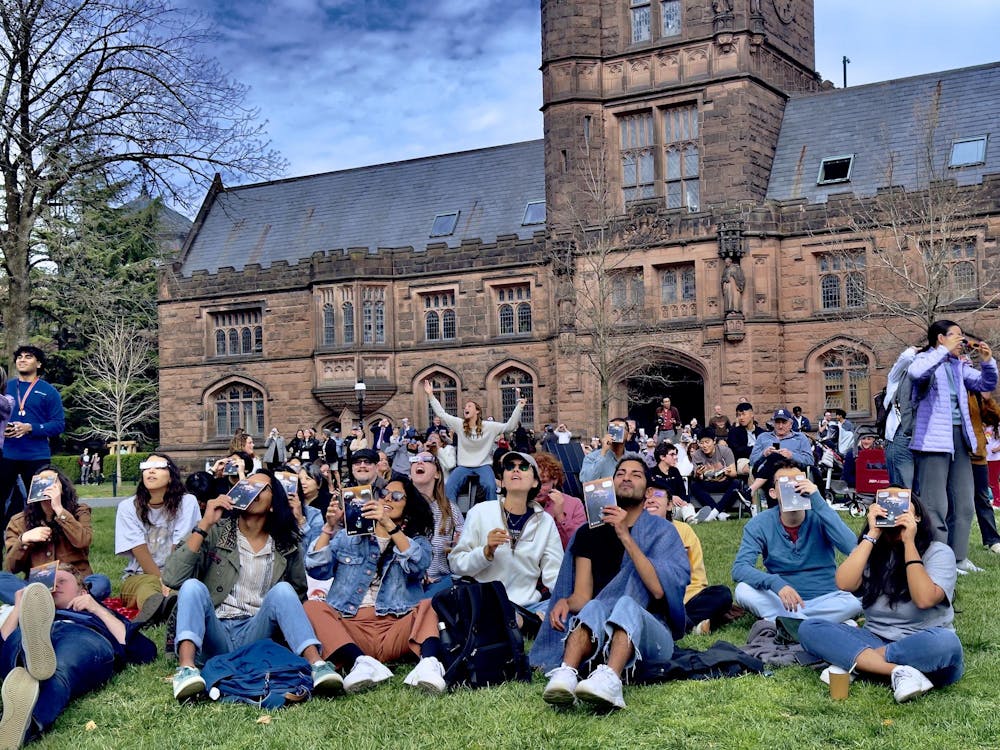The stars aligned at Princeton on April 8 as the Princeton community, along with millions of people across North America, enjoyed the celestial sight as a solar eclipse unfolded overhead.
According to the New York Times, the partial eclipse first made landfall in North America near Mazatlán, Mexico around 12:51 p.m. EST, but the eclipse began in Princeton, N.J. at 2:09 p.m. It reached 90 percent totality at 3:24 p.m. and officially ended at 4:35 p.m.
This is the first solar eclipse to be visible from New Jersey since 2017. The solar eclipse of 2017 was a total eclipse, but it took place near the solar minimum, so eclipse observers saw little activity around the sun. The solar minimum is the period of least solar activity during the Sun’s 11-year solar cycle. During this period, sunspot and solar flare activity greatly decrease and do not occur for even days at a time. For this solar eclipse, watchers in the path of totality — a trail over which the moon fully obscures the sun — could easily see the Sun’s corona and plasma tendrils streaming outwards from the dark center of the moon.

The eclipse during almost full totality.
Veena Krishnaraj / The Daily Princetonian
Students and faculty gathered all over campus and in town to view the eclipse. On Frist North Lawn, the Princeton Astronomy Club (PAC) held an event complete with 100 pairs of free eclipse viewing glasses, chocolate covered espresso beans, and PAC stickers.
Amrita Sahu ’26, Vice President of the PAC and co-organizer of the event on April 8, told The Daily Princetonian in an interview that the club “does a lot of different astronomy related events on campus to spread the love for astrophysics, physics, and astronomy in general. There are a lot of stargazing events that [they] do on Forbes lawn.”
Sahu said that this eclipse viewing party was “one of [PAC’s] biggest events. So many people came by. Everyone just wants to see the eclipse today.”
At an event hosted by the Department of Astrophysical Sciences, the Council on Science and Technology, and the Office of Science Outreach in Palmer Square, Charlotte Ward, a postdoctoral astronomy researcher in the Astrophysics Department, explained to students gathered that “here at Princeton, we’re at 90 percent coverage which means that we can’t see the corona, but we can still see the moon cross the sun and give it this coverage … but even with partial coverage it is still really exciting.”


People gathering in Palmer Square to watch the eclipse.
Veena Krishnaraj / The Daily Princetonian
Ward said, “It is a really great chance to just get a sense of the physical distance between us and the sun and the moon in between. It’s a great chance to come up and ask astronomers what’s going on.”
While the opportunity to ask astronomers questions about the eclipse tempted some, most students went from event to event looking for eclipse glasses to better view the celestial event. Nasir Cook ’25 was exiting Cottage Club when he “heard they were giving out glasses at Palmer Square and decided to come down.”
Cook last saw the eclipse of 2017 at his middle and high school back in Nashville, Tenn., but he told the ‘Prince’ that the Palmer Square event signaled to him that “we can bring people together for almost any event. There are people from all over — not just Princeton students — but people from around the Princeton community, people that are visiting the shops here.”

Like Cook, Ella Bwonya ’26, a student interested in astronomy, also stopped by the Palmer Square event. “Just seeing how many people showed up today is kind of crazy. It says that we are a really close community,” she told the 'Prince.'
Over in Whitman College’s main courtyard, a big crowd came together with picnic blankets, snacks, and eclipse viewing glasses. Though students expressed to the ‘Prince’ that it did not get as dark as they thought it may, Joyce Yang ’27 said, “I give it an 8.5 out of 10. This was really cool.”
“I think if it wasn’t nearly as total then there would still be a big crowd here,” Danielle Schmitt, an academic staff member in the Department of Geosciences, told the 'Prince.'
The year 2044 was thrown around frequently at each event around campus: The next eclipse in the contiguous United States will occur in 20 years — though the path of totality will only be visible in North Dakota, Montana, and South Dakota.
“Maybe I’ll travel in 2044,” Schmitt said.
Hallie Graham is a News contributor for the ‘Prince.’
Senior News writer Justus Wilhoit contributed reporting.
Please send any corrections to corrections[at]dailyprincetonian.com.








